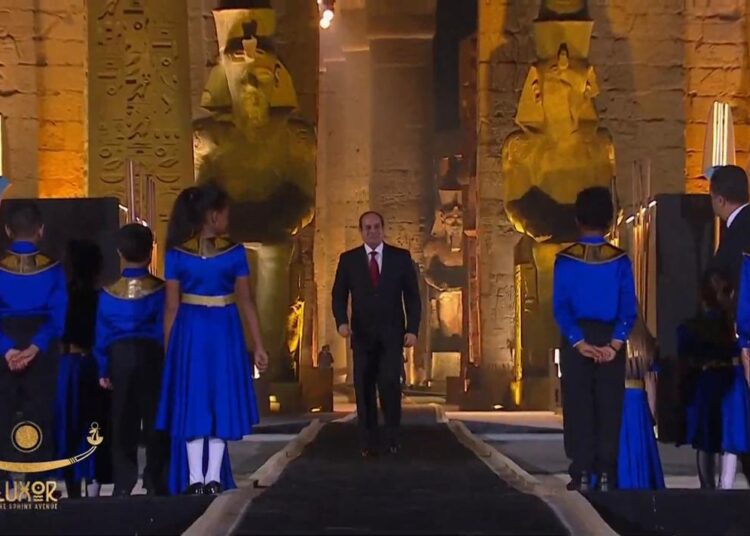Eyes from around the globe were directed to Egypt’s south city of Luxor last night, where the Avenue of Sphinxes (Al-Kebbash Road in Arabic) located at the Karnak Temple Complex, was inaugurated by President Abdel Fattah El Sisi, amid magnificent celebrations.
The King’s Festivities Road dates back to about 3,500 years before, and was constructed to witness the annual celebrations of the Opet Festival, feasts and special occasions, as well as the coronation of kings. Processions used to extend from the Karnak Temple in the north to Luxor Temple in the south.
The major national project is most likely to add to Luxor as being an open museum as it connects the temples of Karnak and Luxor with a length of 2,700 meters, width of 76 metres, and 1,200 statues of Sphinxes on both sides. Each has a weight of 5-7 tonnes, and height of about 3.7 metres, with a lion’s body and a ram’s head. They include the statue of Ramses II, the symbol of protection.

The sphinxes symbolise God Amun, which represents fertility of the ancient Egyptians, and the Ancient Egyptians called it “Wat-nTr”, meaning the Path of God. They were carved in a single block of sandstone with a cornice inscribed with the king’s name and title.
The avenue is divided into 3 main parts; the first begins at the tenth edifice of Karnak Temple going south over a distance of 300 metres until the gate of the Temple of Mut. This is the oldest part of the avenue visible so far.
The second part includes statues of whole rams, placed in front of Khonsu Temple, in the Karnak Temple Complex that dates back to the era of Amenhotep III, who started the construction of the Luxor Temple. The statues were brought to their present place during the reign of King Herihor, of 21st Dynasty.

The third part extends from the Mut westwards, to the Nile, over 200 metres long, and then southwards for 2000 meters until it reaches the Luxor Temple.
Between each statue base and the other, there are circular basins of flowers where water is delivered through small canals of red bricks. There is an integrated network along the avenue to irrigate trees and flowers. Visitors will also see two wine presses, that only complete presses in Upper Egypt, where grape was pressed, preserved and stored.
Visitors will also watch several places that were used for manufacturing tubes and containers for preserving wine, besides the warehouses where the vessels were stored. There are also old basins for washing grapes with drainage channels. Both are in good condition.

In addition, there are places that were used for manufacturing amulets and pottery figurines. Other items along the avenue also include a circular nilometer provided with an internal gauge for measuring the water level in the Nile.
Key architectural elements there tell the story of the social, cultural, economic and religious life of people in Thebes through the ages.
Inauguration of the Avenue of Sphinxes was the second global event taking place in Egypt after the opening of the National Museum of Egyptian Civilisation, which included a spectacular Pharaohs’ Golden Parade that saw the transferring of 22 mummies from the Egyptian Museum in Tahrir to their new home.






Discussion about this post